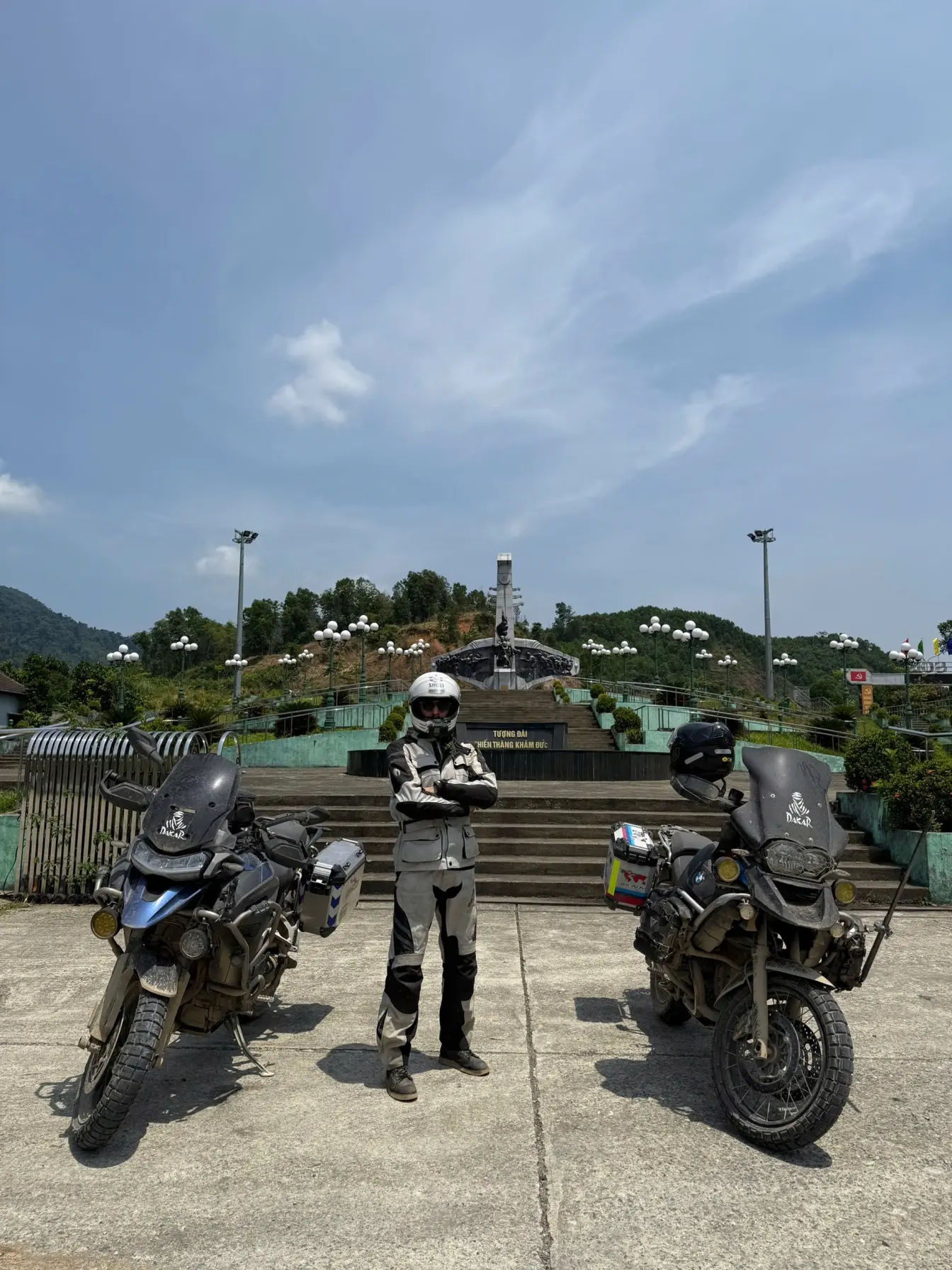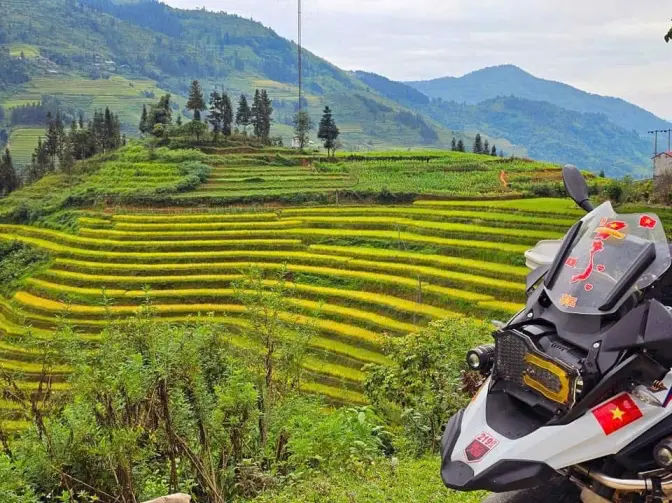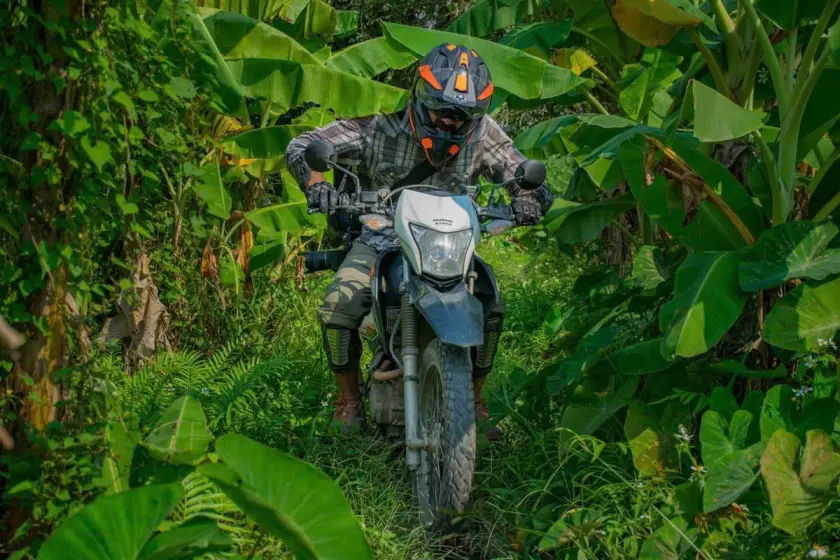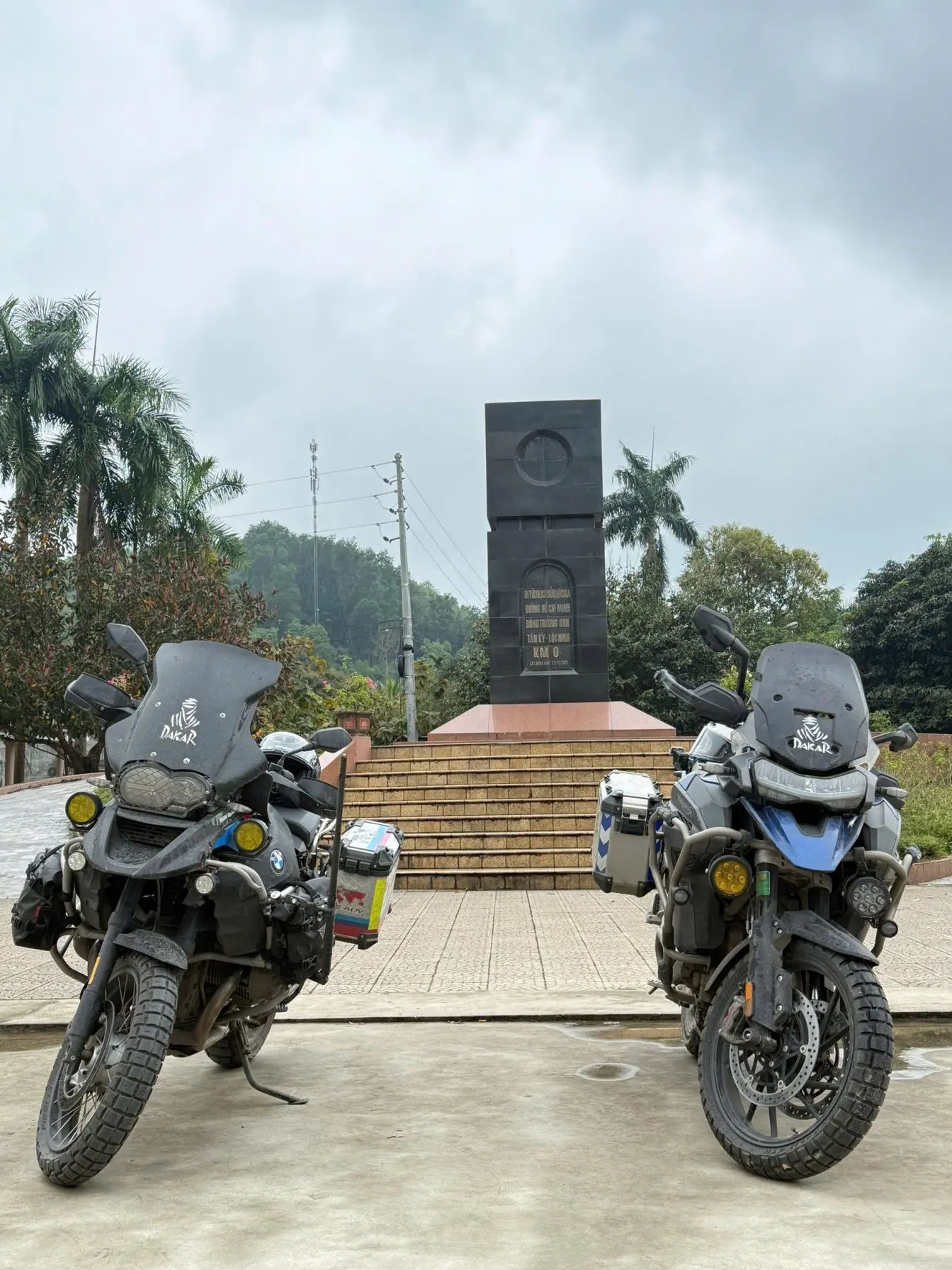
Hi adventure riders, Hamid here and in this post, im going to share about the hidden gems along the Ha Giang loop. Imagine riding through misty mountain passes, the wind in your hair, and the scent of earth and pine in the air, that’s the ride along the Ha Giang twisty roads at its rawest. The region is tucked away in northern Vietnam, this some 1000-kilometer journey isn’t just about the famous bends or viewpoints, beyond them. For those who crave adventure, the lesser-known routes like Tham Ma Pass, Du Gia Waterfall, and hidden ethnic villages offer something deeper , spend time and explore the untouched beauty and genuine connections.
Of course the usual, let’s say, the classic loop will always surprise you with it’s beauty and landscapes, however, in this post, we skip the crowded paths, take the rougher roads, and you’ll find the real heartbeat of Ha Giang. Check out Best motorbike tours in Vietnam
Why the Loop ride in Ha Giang Is a Unique Destination for Adventurers
Because riding every twist and turn of the Ha Giang Loop delivers raw adventure, dramatic mountain passes, remote villages, and unfiltered glimpses of Vietnam’s wild beauty that few travelers ever see, ever ever…
Picture this, you, a motorbike, and raw mountain road that keeps surprising you, switchbacks that feel like roller-coasters, rice terraces folding into the valley, and tiny villages that time forgot. The Ha Giang motorcycle Loop is a special experience, because it isn’t just a drive through astonishing landscapes, it’s a layered adventure where every detour (Tham Ma Pass, Du Gia waterfall, remote hill-tribe markets) changes the story of your day and tests you in the best possible way.
What makes riders whisper about Ha Giang among the riders and curious travelers is the epic, photogenic passes that demand being discovered, and off-track dirt roads that reward curiosity. Hit along Hogn Su Phi for those insane zigzags and viewpoints, then peel off toward Du Gia to swim in a hidden pool and sleep in a homestay, that contrast of adrenaline-and-silence is addictive.
local markets, elderly hill-tribe women selling handmade crafts, kids running after your bike, and suddenly the Loop isn’t a checklist, it’s a series of honest, small moments that feel cinematic. That’s why many riders recommend spending 4–7 days: it lets you slow down, get lost on secondary tracks, and actually meet people instead of just snapping photos.
- Check out Ha Giang loop map
A piece of advice from real riders
A fair advice from every rider i usually read through thread and travel groups, if you’re into pure adventure, then, this route rewards skill and by that, I mean, the off-road motorbike riding skill. Roads get rough, weather flips fast, and the best detours are of-course unpaved, so either be a confident self-rider or be a part of a tour with those who knows the plates and pitfalls. Do that, and the Loop flips from intimidating to unforgettable.
At the end of each day, Ha Giang is exciting by all means, because it mixes crazy beautiful sceneries, challenge, culture, and discovery into a single road trip. If you want postcards, stick to the main stops; if you want a story you’ll tell at 3 a.m. with a beer in hand, go slightly off the beaten track and let the Loop surprise you.
Getting to Know the Ha Giang Loop
The Ha Giang region sits in Vietnam’s far north (480km from Hanoi city), there is no airport here, though the closes is the Noi Bai International airport in Hanoi, you basically tide your motorcycle along the villages and landscapes along the border with China.
The region used to be close to travelers and everyone needed a permit to visit the area, but Ha Giang was opened to travelers only in the early 2010s, which is why it still feels untouched compared to other tourist trails.
The main loop stretches long, winding through mountain passes like Ma Pi Leng, Dong Van, and Meo Vac, where every corner reveals a new jaw-dropping panorama.
Roads have improved over the years, with smoother asphalt along the main loop, but the smaller routes, especially those toward Du Gia or Lung Cu, Hoang Su Phi and along the route DT177, remain rugged and full of adventure.
It’s not just geography that defines this ride; it’s the rhythm of the road itself, steep climbs, hairpin turns, and unexpected detours that makes part of the region lesser-known and most tourist will not even think of the adventure through the less-touristy parts.
Here are the Lesser-Known Routes of Ha Giang ( alternative itineraries)
Here are some alternatives and lesser-known routes in Ha Giang made for motorbike riders. Buses or cars can’t easily handle these roads unless you’re in a 4×4. Explore remote ethnic villages along Xin Man, DT177, and Hoang Su Phi. Visit Lo Lo villages, venture deep into Du Gia and Hoang Su Phi, and ride through the scenic, less-traveled stretches of Mau Due and Bao Lac.
These sections would definitely takes your ride toward the more local regions far away from the main tourist crowds.
Rural and Off-the-Beaten-Path Trails
Head toward the countrysides, roads leading to villages like Du Gia, Nam Dam, or Lung Tam take you through remote valleys where life mo
ves to the rhythm of nature. These are routes where water buffalo outnumber motorbikes, and locals wave as you pass through terraced rice fields and wooden stilt houses. The roads can be dusty, bumpy, muddy and narrow, but that’s part of the roads less traveled. Every turn feels strange and different, like you’ve stumbled into a Vietnam most travelers never see.
Forest and Mountain Routes
For those of you interested in adventure along the forest and mountain trails, the Ha Giang offer a raw, cinematic experience (Watch a few Vimeo video and wow). Picture yourself winding through misty pine forests along the Yen Minh roads to the villages, hearing only the hum of your engine and the whisper of wind through bamboo. Sections around Dong Van Karst Plateau and Du Gia National Park are particularly stunning, blending wild mountain beauty with moments of complete solitude.
These routes are for riders who don’t just want to see the landscape, they want to feel part of it. Think narrow dirt paths, unpredictable slopes, and the reward of reaching viewpoints that no map can prepare you for.
Hidden Viewpoints and Scenic Stops
Beyond the big names like Ma Pi Leng Pass, Ha Giang hides dozens of unnamed lookouts where the views are just as spectacular, and you’ll have them all to yourself. Some of the best are found by simply following a side road or asking a local for “điểm ngắm cảnh” (viewpoint).
Pull over between Yen Minh and Dong Van to catch golden light hitting the karst peaks, or take a detour toward Du Gia for a swim beneath a hidden waterfall. The charm lies in discovery, no signs, no crowds, just you, your bike, and the open mountains.
Map: Some off-road trails for planning your itinerary
The Nho Que river ( Tu San Canyon)
The Nho Que River, with its shimmering emerald-green waters, winds through the dramatic TuSan Canyon, creating one of Ha Giang’s most breathtaking natural scenes. I didn’t seriously wanted to add it since it is not considered a lesser-know but a so touristy one most of the times, but here you are. The river is flowing from China’s Nghiem Son Mountains, the river offers a peaceful 1.5-hour boat or kayak ride through cliffs that soar up to 1,000 meters high.
Tickets cost around 100,000–150,000 VND per person, and the views are truly unforgettable. Though the area has become more popular, it still feels serene, especially if you visit early in the day. It’s absolutely worth it for anyone exploring the Ha Giang, offering that perfect mix of beauty and adventure without feeling overly touristy.
Hồ Noong (the lake)
Lake Noong, it’s crossing through Phu Linh commune about 23 kilometers from Ha Giang town, feels like stepping into a quiet, untouched world. Fed by underground springs that flow through caves between two mountain ranges, the lake winds gently around steep cliffs before connecting to the Lo River.
During the rainy season, its waters rise dramatically, giving the place a wild, powerful beauty. Travelers come here for the peace, to watch the purple glow of sunset reflect on the lake, see smoke curling from Tay stilt houses, and hear buffalo calls echo across the valley. It’s a simple, soulful escape where nature still sets the rhythm, and it’s absolutely worth a stop on your Ha Giang journey.
Thon Tha hamlet (+ its waterfall)
Just a 10 minutes ride from the center of Ha Giang city (the KM0 point), Thon Tha Village welcomes you with calm, authenticity, and the charm of Tay ethnic life. Known for its stilt houses and terraced rice fields, this small village feels like a step back in time. The air is fresh, the scenery lush, and the pace beautifully slow.
A short walk or motorbike ride away, a hidden waterfall offers the perfect place to cool off after exploring the rice fields. Whether you’re staying overnight or just passing through, Thon Tha delivers that rare blend of natural beauty and cultural warmth that makes Ha Giang so unforgettable.
Essential Tips for Adventurers
Safety and Must-Have Gear
Ha Giang’s beauty comes with its challenges, steep slopes, unpredictable weather, and sharp turns that test even experienced riders.
A proper helmet, gloves, and waterproof layers are non-negotiable. Bring a small first aid kit, bungee cords<p>for your bag, and knee protection if you plan to explore rougher trails. Locals and seasoned riders often remind newcomers: ride slow, enjoy the view, and never underestimate the mountains. Confidence is key, but respect for the road keeps you safe.
- Check out How dangerous Ha Giang is
Best Seasons to Travel
The ideal time to ride the Ha Giang Loop is between <strong>September and November when the weather is cool and the rice terraces glow gold.
March to May also offers clear skies and blooming buckwheat flowers painting the hills in soft pinks and purples.
Avoid heavy rains from June to August, landslides and slippery roads can turn a scenic ride into a stressful one. Winter months (December–February) bring chillier air and fog, adding drama to the landscape but requiring warm layers.
- Check out the best months to ride the Ha Giang
Choosing the Right Motorbike for Rough Terrain
Anything above 150cc is perfect. This is a very picky option, I myself won’t ride scooter and anything less than 125cc around Ha Giang, I know, we know, and we read atoms of backpackers did the classic loop with only a automatic scooter.
However, here we’re talking adventure and roads less travelled, which means, you’ll need a proper motorcycle. Enough said.
Most riders recommend a 150 cc motorbike such as Honda 150XR or the newer version, the 190L.
For slippery terrain and off-roads, we recommend CRF 250, and if you’re a rider with more experience under your belt, then go ahead with CB500x , this lighter ADV machine will be a perfect travel company that ay no to any road.
Conclusion: Off the beaten track across Ha Giang loop
I remember my first visit to Ha Giang back in 2009. A lot has changed since then, and that makes travel planning much easier. Riding the Ha Giang Loop, if you ask me, is more than just a trip — it’s an experience we all want to make unique. So why not take the roads less traveled?
Go off-road and feel the difference at every turn. Mist curls over mountain ridges. Sunlight bursts through the clouds. A local waves as you roll into a quiet village. From the rugged slopes of Ma Pi Leng Pass to the dirt tracks leading to Du Gia and Nam Dam, each stretch of road tests you, rewards you, and teaches you to slow down. At the end, I suggest you to check northern Vietnam ride with Ha Giang
Frequently Asked Questions (FAQ)
What is the best time to ride the Ha Giang Loop?
The best time is from September to November through March to May. The weather is clear, cool, and perfect for long rides. You’ll catch golden rice terraces in autumn and wildflowers in spring. Avoid the heavy rains from June to August, landslides and slippery roads can make the ride tricky.
How long does it take to complete the Ha Giang Loop?
Most riders take 3 to 5 days, to ride the classic Ha Giang (very touristy), but if you can spare 6 to 7 days, you’ll get to explore the quieter trails and hidden villages where no tourist steps in. I strongly recommend you to go off the beaten track and thank me later.
Can beginners ride the Ha Giang Loop safely?
Yes, but only if you’re confident on a motorbike and know your limits. The roads are steep, winding, and unpredictable. If you’re new to riding, join a planned tour or hop on a pillion motorbike tour. This way, you can relax, enjoy the views, and stay safe on the road.
What kind of motorbike is recommended for the Ha Giang Loop?
I recommend using a manual motorbike with at least 150cc power. Of course, it depends on your budget and riding skills. If you plan to take rough backroads or dirt trails, choose a manual bike like the Honda XR150 or a Suzuki.
Are there places to refuel and get food along the route
Absolutely. The roads and northern frontier lines are 100% improved compare to back in 2009 when I ride the area. You’ll find fuel stations and small family-run eateries in most remote towns and villages. Many locals even set up small roadside pumps to sell petrol.
- You may need to learn about fuel types in Vietnam















